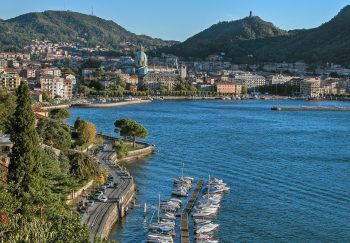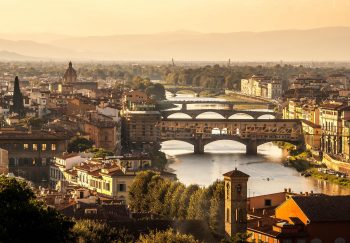Lasagna, when done properly, is a beautiful dish and one of the most loved Italian food dishes. There is a huge difference between authentic lasagna, and frozen lasagna. Loredana, our Italian home cook expert, was kind enough to give us a recipe. We are sure you will find the recipe for authentic Italian pizza to be just as popular as her blog post. If you have any questions or comments, please don’t hesitate contacting us in the comments section.
Before we start…
Note on the origins and use of dried pasta in Italian lasagna
There are many variations of Lasagna, both in Italy and abroad. However, when we refer to “real” lasagna, we mean “Lasagna al Bolognese”, which is a Bologna-based recipe from Emilia-Romagna. The long, flat strips of pasta that are used to make lasagna layers are a traditional shape in this region. These strips can be bought dried by some Italians, but it is still common to make them at home in Emilia-Romagna, as well as other regional specialties such tortellini.
Pastagna made with fresh egg pasta sheets is always better than those made from dried eggs. We are fortunate enough to be able buy fresh, high-quality pasta sheets from Pastificio. These pasta sheets are cheap and easily available outside of Italy. Don’t be discouraged if you don’t have fresh pasta on hand. Once you learn the basics, you will soon be able to make fresh pasta in no time. Dried pasta can be used if you don’t have time or the desire to make fresh pasta. However, you will lose the taste and texture. We have your secret, but you can rest assured.
Ingredients
To make pasta sheets
For a casserole pot of 20cmx30cm
- 400g Flour *
- 4 eggs
- Use a cutting board or a clean countertop to work the dough
To the Ragu
- 1 small carrot
- 1 white onion
- 1 small stalk of celery
- 2 tablespoons Extra Virgin olive Oil
- 250g tomato sauce, no seasoned Only tomato sauce
- 500g minced beef
- 350g minced pork
- 1/2 glass white wine
- Salt
- Ground pepper
For the “besciamella sauce”
- 1 Liter of milk
- 100g (7 tablespoons, or slightly less than 1/2 cup) butter
- 80 grams (2/3 cup) all-purpose flour
- A small amount of Nutmeg
- Salt, a pinch
- One pinch of ground pepper
* “0” or “zero flour in Italy is a refined white flour that’s used to make pasta. Although it isn’t as refined as “00”, or “doppio Zero” flour, it is usually more refined than the white flour found in stores outside of Italy. Your all-purpose white flour can be used if you don’t have any 0 flour. However, the consistency may differ slightly. While purists may be apprehensive, we don’t mind using regular flour if we run out of “0”.
Make a flour volcano by combining the eggs with the flour!
1. Prepare your pasta sheets
- You should place most of the flour on your cuttingboard (reserve 50g or so, less than 1/3 cup). Wood is the best material for kneading on but you can also use plastic boards or your countertop. Make a hole in the middle of your little pile to make it look like a volcano.
Chef’s tip: Drying pasta dough in a drafty area can lead to it drying out. Make sure you choose a dry and cool place for pasta making.
- Mix the eggs in the “crater”, and then stir them together with a fork.
- Slowly add more flour from the edges of the “crater” to the eggs and flour. Continue to mix the flour and eggs until you get a cohesive mixture.
- For 10 minutes, knead the dough by pressing it down with your heel. Then, turn it over, stretch it, fold it, and then smash it down again. Kneeling is essential to make the dough more elastic and work with the gluten.
Chef’s tip: Add warm water to soften the dough. You can add some of the flour that you have left over from the beginning to make it a bit more sticky. You should not add more flour than you have specifically reserved for this purpose.
- Wrap the dough in plastic wrap and let it rest in a dry area for 30 to 24 hours. This is especially important if you roll your pasta by hand as it helps to relax the gluten. You won’t be able to relax the gluten and roll it out with a rolling pin if you don’t. You don’t have to let the dough relax if you use a pasta machine, but it is worth noting that the final product may be stiffer.
- Sprinkle some flour on your cutting board. Wrap the dough in a towel and gently press it down with your palm. You now have two choices: a rolling pin or a pasta maker!
- You can also use a rolling pin by sprinkling flour on the dough. Then, roll the pin back-and-forth using light pressure until it is a thickness of about 0.5mm.
Chef’s tip: After approximately a minute of rolling, wrap the far edge around the pin. Hold the opposite edge in your hand, and then roll the pin towards you. Roll it in order to “unfold”. Rotate the dough 90 degrees to the right after it is unfolded.
- If your pasta-making machine has a cutting board, divide the dough into quarters (or eighths depending on its size). Then, flatten one quarter of the dough, and then sprinkle flour over it before feeding it into the machine. Start with the thickest setting, i.e. the largest. Once you have rolled one strip, fold it in half. Then pass it through the machine again. Reduce the width of your rolling slot until it reaches a thickness of about 0.5mm. Remember that the width of your rolling slot must be reduced twice. For the second pass, fold the dough in half.
Chef’s Trick: Wrap the strips that you just made in plastic wrap and then stack them on top.
- Cut the large sheet of pasta or the small strips into rectangles measuring approximately 20 cm x 14cm (8 inches x 6 inches). Then, boil water for 30 seconds. Set them aside on kitchen towels.
2. Your Ragu is ready
- While you peel and cook the onion and carrot, heat a good glug olive oil in a large saucepan or dutch oven. The celery should be washed and dried. The celery should be cut into small pieces. Cook them on a low heat for about 5 minutes or until they become soft.
- Turn the heat up to medium-high, and then add the ground beef or pork. Once the meat is browned and any liquid that it has released has evaporated add the white wine. Stir. Once the wine has evaporated add the passata and salt. Mix the ingredients again and cook for about an hour on low heat.
Chef’s tip: The longer the ragu cooks the better it tastes. The grandmothers of our generation would simmer their ragu for up to 12 hours. To allow the sauce to simmer for this long, it is important to reduce the heat to a low temperature (but not so much that there are small bubbles on the surface) and to stir the mixture from time to time. It is best to taste it before you decide if it is ready.
3. Make your Bechamel sauce
Set aside the ragu and prepare your bechamel or, as it is known in Italy, “Besciamella”, sauce.
- Heat the milk in a saucepan. Do not let it boil.
- Make the butter into cubes and heat it in a separate saucepan. Once the butter has melted, take it off the heat. Whisk in the flour slowly until it is incorporated.
- Return the pan with butter and flour mixture to a low heat. Add warm milk, salt and nutmeg. Use the whisk to combine the butter and flour mixture. Continue stirring until it becomes thickened.
Chef’s tip: Make sure to stir until all ingredients are incorporated. This will prevent lumps from forming in your bechamel sauce
4. It’s time to put the lasagna layers together
- Sprinkle a layer of besciamella over the casserole.
- You can cover it with a layer ragu.
- Place the pasta rectangles side by side on top of ragu until it is completely covered. You don’t want them to overlap.
- Continue the process until you have reached 5-6 layers of pasta. Place a thicker layer (or ragu) on the last layer of pasta. This is because it is the most exposed to heat and tends to dry out a bit. Sprinkle some parmesan cheese between the layers, or on top of them if desired, but it is not necessary.
Chef’s tip: Many Italians alternate the order of their lasagna layers to keep it from falling apart after being cut and served. If you laid your first layer of pasta lengthwise you will place your second layer crosswise. This may seem insignificant, but it is one of those nonna secrets that we swear by.
5. Bake!
- For approximately 25 minutes, place the casserole in a preheated oven at 200 degrees Celcius (390 F). The lasagna will be ready when the top layer has a golden crust.
- Allow your lasagna to rest for at least a few minutes before you cut it and serve. Enjoy!











